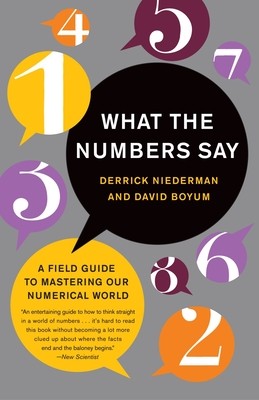
- We will send in 10–14 business days.
- Author: Derrick Niederman
- Publisher: Crown Publishing Group (NY)
- ISBN-10: 0767909992
- ISBN-13: 9780767909990
- Format: 13 x 20.3 x 1.5 cm, minkšti viršeliai
- Language: English
- SAVE -10% with code: EXTRA
Reviews
Description
Our society is churning out more numbers than ever before, whether in the form of spreadsheets, brokerage statements, survey results, or just the numbers on the sports pages. Unfortunately, people's ability to understand and analyze numbers isn't keeping pace with today's whizzing data streams. And the benefits of living in the Information Age are available only to those who can process the information in front of them.
What the Numbers Say offers remedies to this national problem. Through a series of witty and engaging discussions, the authors introduce original quantitative concepts, skills, and habits that reduce even the most daunting numerical challenges to simple, bite-sized pieces. Why do the nutritional values on a Cheerios box appear different in Canada than in the U.S.? How is it that top-performing mutual funds often lose money for the majority of their shareholders? Why was the scoring system for Olympic figure skating doomed even without biased judges? By anchoring their discussions in real-world scenarios, Derrick Niederman and David Boyum show that skilled quantitative thinking involves old-fashioned logic, not advanced mathematical tools. Useful in an endless number of situations, What the Numbers Say is the practical guide to navigating today's data-rich world.EXTRA 10 % discount with code: EXTRA
The promotion ends in 23d.00:54:27
The discount code is valid when purchasing from 10 €. Discounts do not stack.
- Author: Derrick Niederman
- Publisher: Crown Publishing Group (NY)
- ISBN-10: 0767909992
- ISBN-13: 9780767909990
- Format: 13 x 20.3 x 1.5 cm, minkšti viršeliai
- Language: English English
Our society is churning out more numbers than ever before, whether in the form of spreadsheets, brokerage statements, survey results, or just the numbers on the sports pages. Unfortunately, people's ability to understand and analyze numbers isn't keeping pace with today's whizzing data streams. And the benefits of living in the Information Age are available only to those who can process the information in front of them.
What the Numbers Say offers remedies to this national problem. Through a series of witty and engaging discussions, the authors introduce original quantitative concepts, skills, and habits that reduce even the most daunting numerical challenges to simple, bite-sized pieces. Why do the nutritional values on a Cheerios box appear different in Canada than in the U.S.? How is it that top-performing mutual funds often lose money for the majority of their shareholders? Why was the scoring system for Olympic figure skating doomed even without biased judges? By anchoring their discussions in real-world scenarios, Derrick Niederman and David Boyum show that skilled quantitative thinking involves old-fashioned logic, not advanced mathematical tools. Useful in an endless number of situations, What the Numbers Say is the practical guide to navigating today's data-rich world.

Reviews